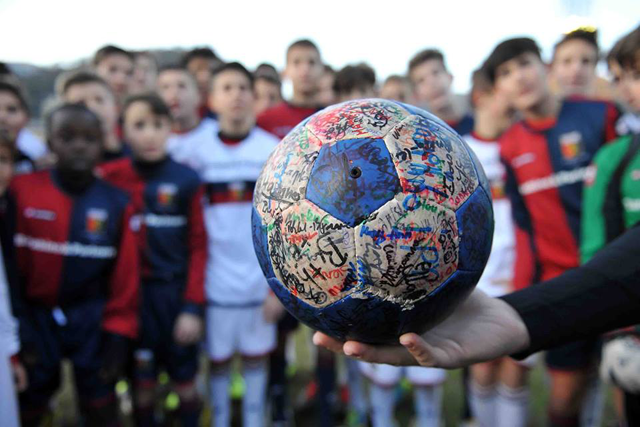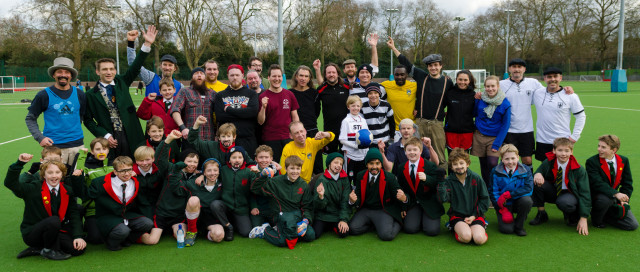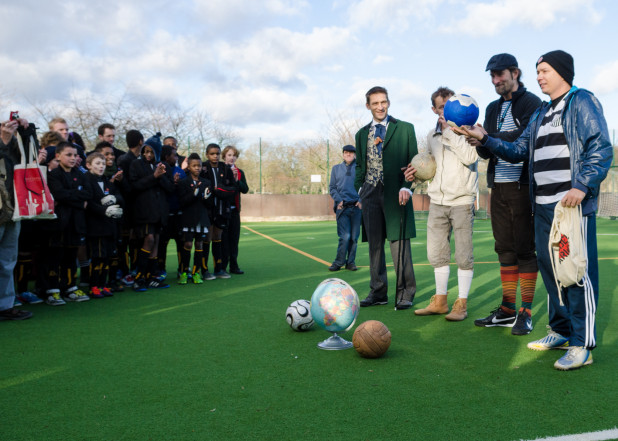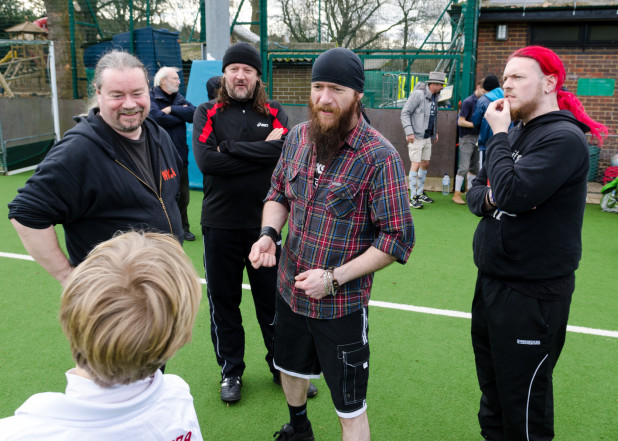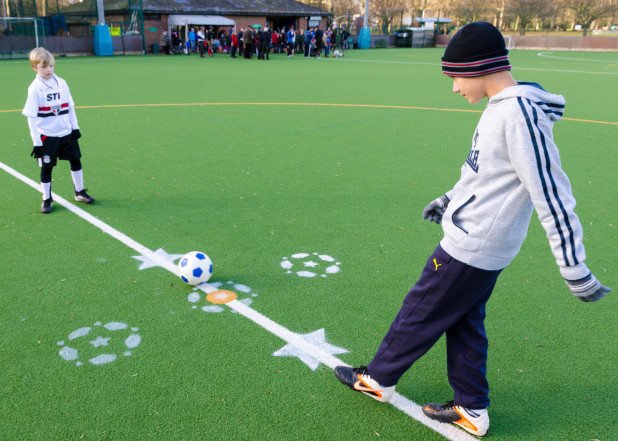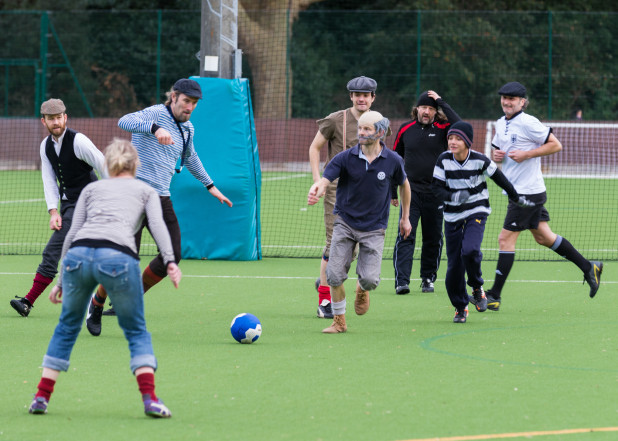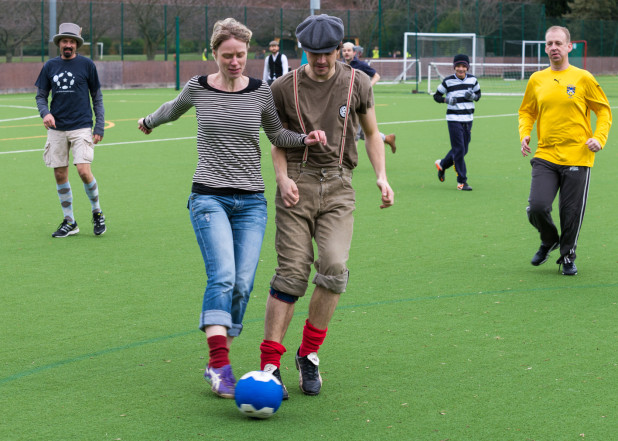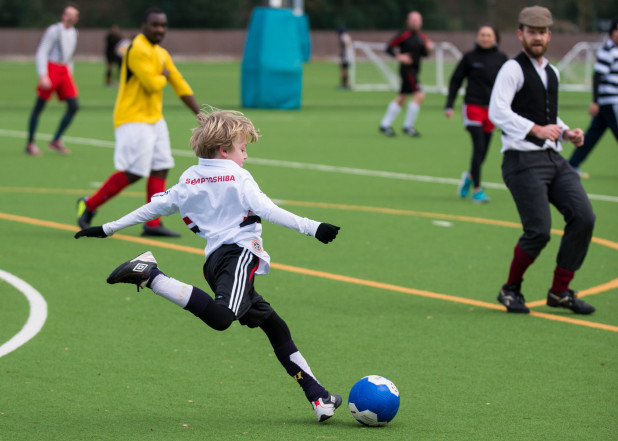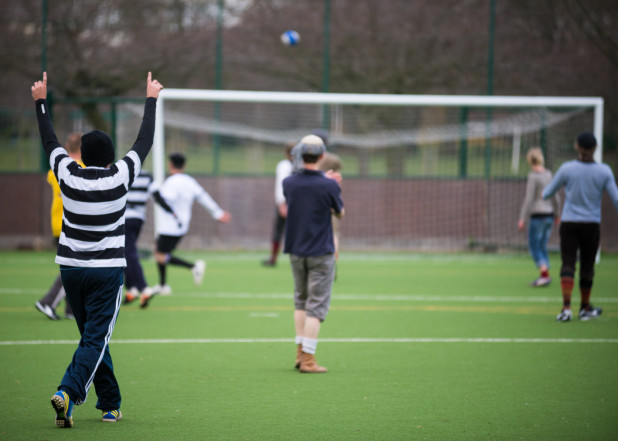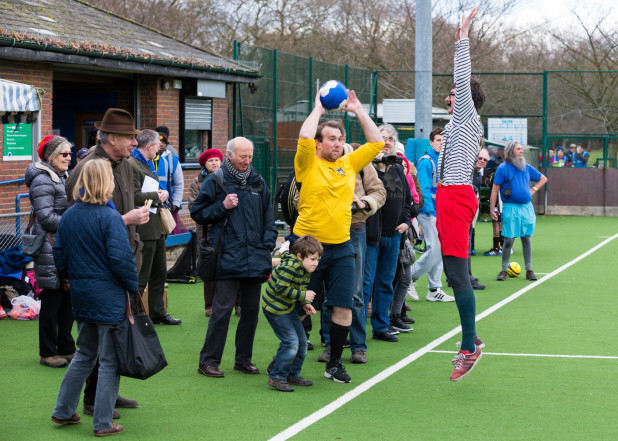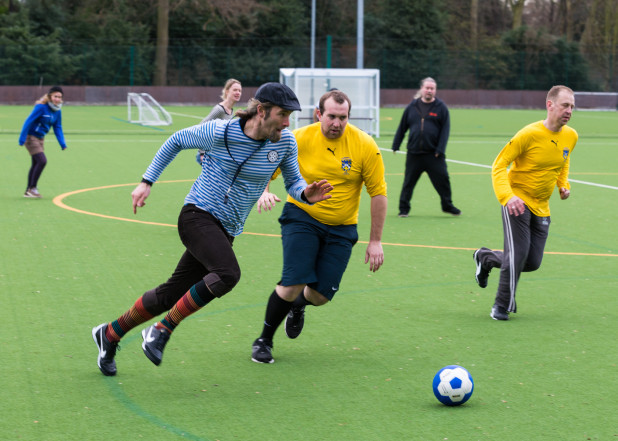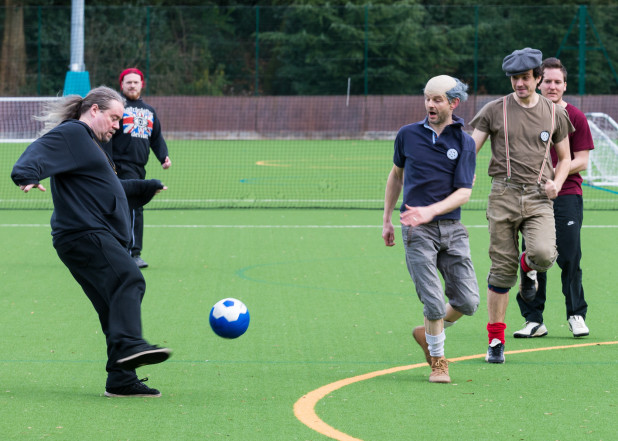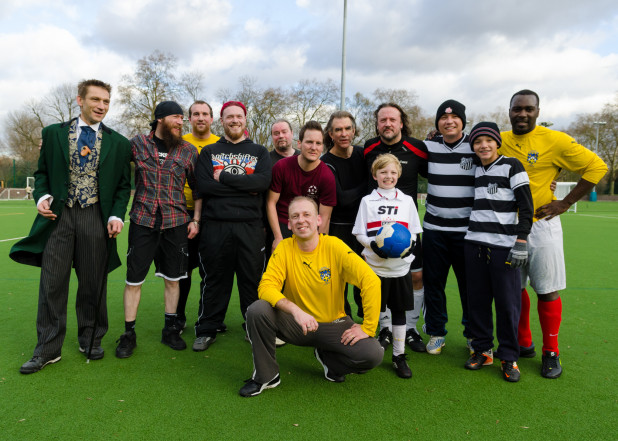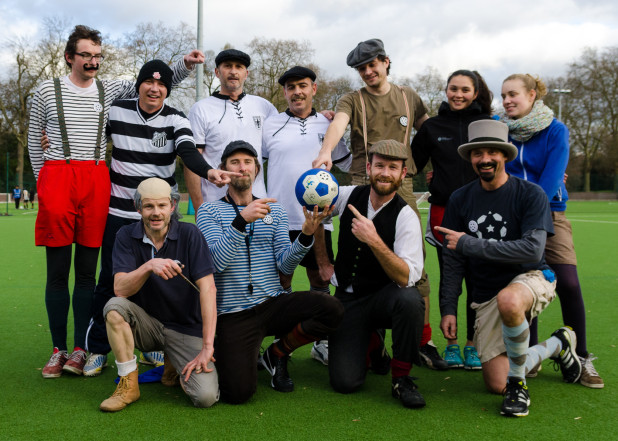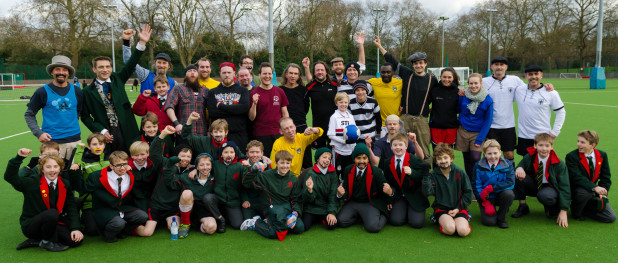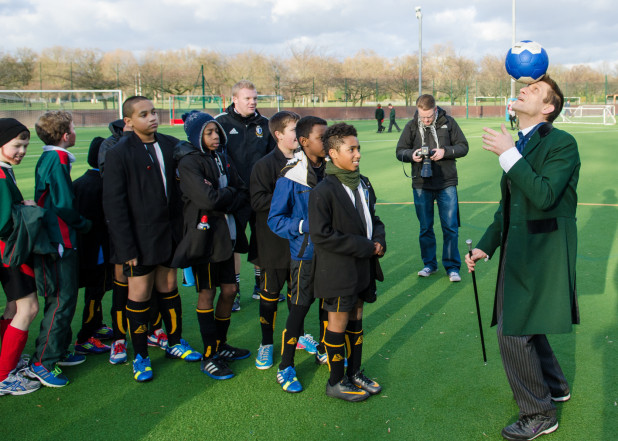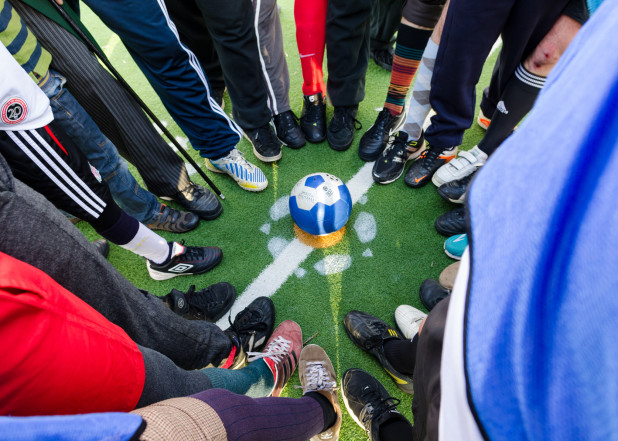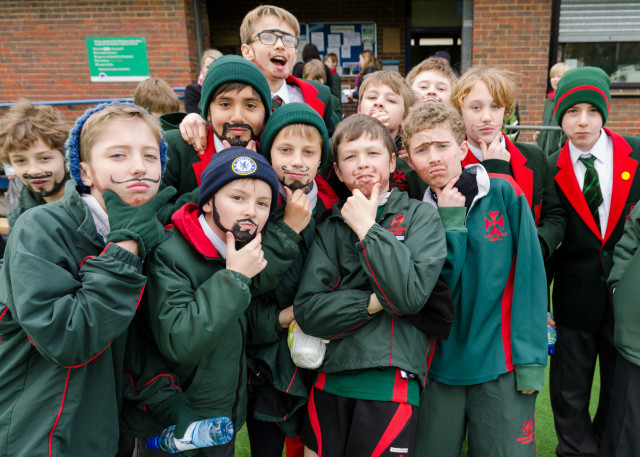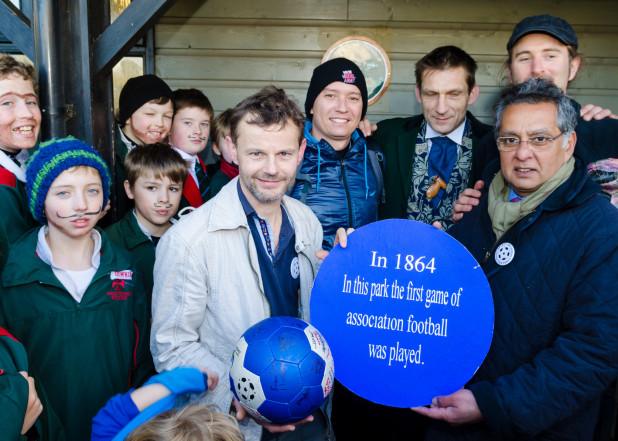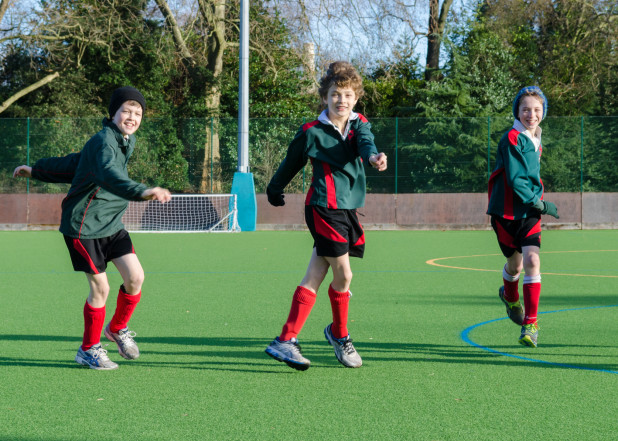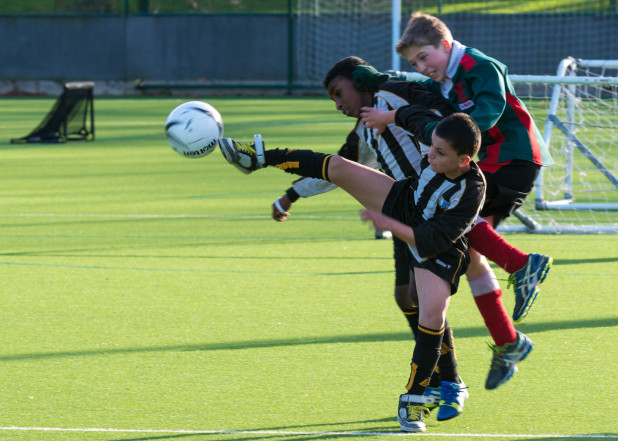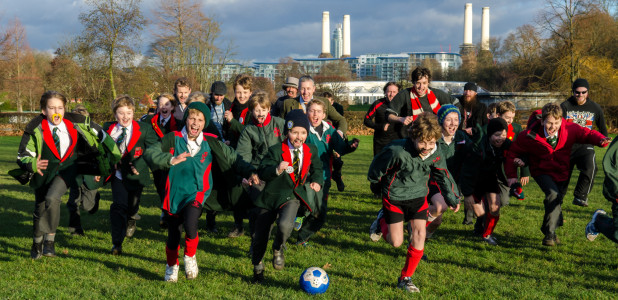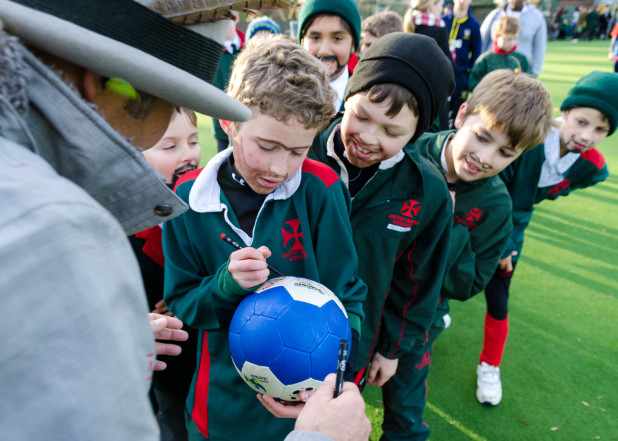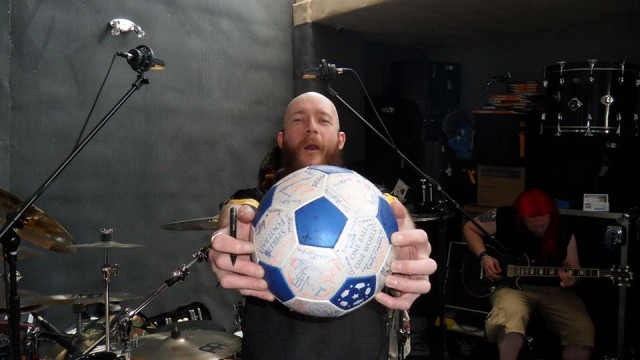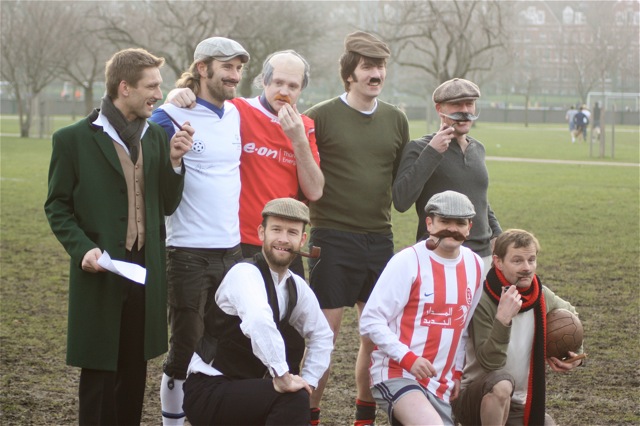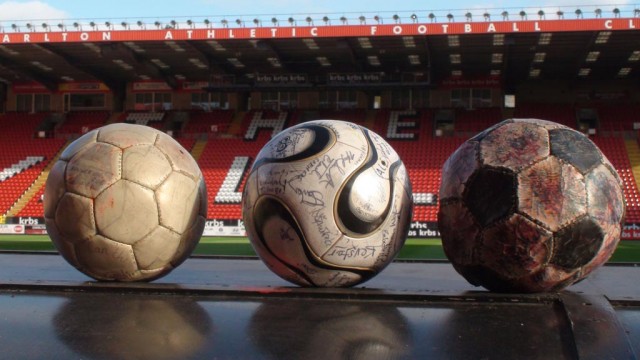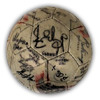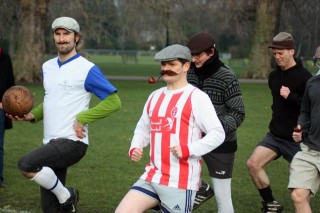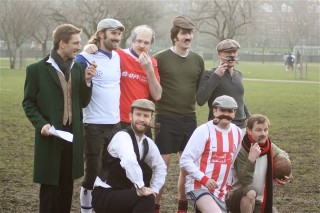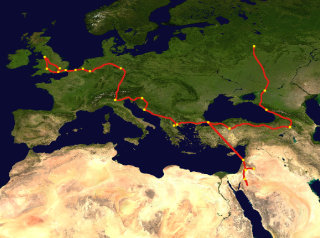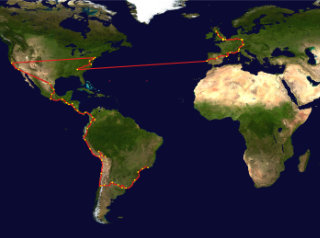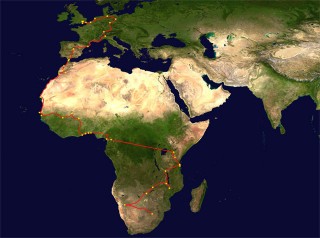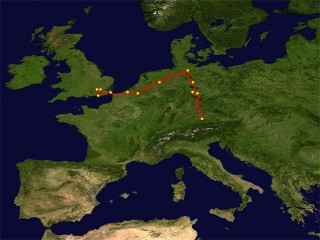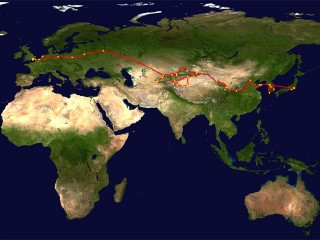Players gathered in Battersea Park, London from all over the world — from Brazil, New Zealand, Germany, Yemen, Brighton and Bradford — to commemorate the 150th anniversary of the first official game played there under the new Football Association rules. Back in 1864, the exhibition match boasted teams consisting of the best football players there were. This time around, the expectations of a great game were no less lofty.
The players divided into two teams of 11, three less per side than in the original game, but this was absolutely fine since the captains agreed to the number. On one side, the Brazilian contingent led by Fernando Godoy, allied with the members of New Model Army, looked sharp and promised much. On the other, the German contingent led by Andrew Aris, along with sundry others including Phil Wake — a veteran of three previous kick-offs — had the greater experience. Who would prevail?
The coin was tossed, Fernando chose heads but it landed tails. Andrew chose to play from the half his team was already in and so Fernando was obliged to kick off. The whistle blew and mayhem ensued. In 1864, there was no referee because no-one imagined that gentlemen could not agree a solution when disputes occurred. The 1863 rules, however, make no mention of a referee, so it wasn’t technically an infringement for me to help proceedings along against a backdrop of shouts from crowd and players alike of “Oi! Ref! Get a new monocle!”
The tendency to pass the ball forward to a team-mate — indeed the ungentlemanly tendency to pass at all, an unsavoury habit ingrained through years of playing the modern game — seemed the most common infringement, though my whistles were largely ignored. Yet, as the game progressed, the players began policing themselves and gentle reminders to team-mates to pass backwards proved more effective than my own protestations.
Both teams adopted a long-ball game, a tactic popular on these shores to this very day — even the highest levels. It worked better for Fernando’s team who had the benefit of two young ringers named João Pedro and Callum running rings round Andrew’s relative veterans. Indeed, so successful a tactic was it that it led to the first goal, scored by Joao with a lofted shot that passed between the posts about 5 metres over the new-fangled — and for this game meaningless — “crossbar”.
Much spectator hilarity derived from the outside-the-touchline scuffles and shambolic throw-ins guaranteed by Rule 5:
“When the ball is in touch, the first player who touches it shall throw it from the point on the boundary line where it left the ground in a direction at right angles with the boundary line, and the ball shall not be in play until it has touched the ground.”
This amusing yet perilous clause — along with its twin that deals with the goal line — were later dropped from the rulebook, presumably at the request of the sport’s less hardy onlookers, faced as they were at any given moment by the prospect of serious injury.
Although goalkeepers were not introduced until 1870, Justin Sullivan performed two miracle headers in front of goal to deny Andrew’s team the goal they sought. Calling “mark” might have been tactically better, since a free kick would have been awarded from the point at which the ball was caught, but Justin’s headers were far more deserving of a slow-motion action replay. Whatever that is.
Throughout the game, both Fernando and Andrew made powerful dribbling incursions into opposition territory that were a constant threat. But it was one of Andrew’s surging runs combined with Phil’s combover, which seemed to behave like a 12th player, that caused so much consternation and pressure that it eventually led to an equaliser.
After changing ends, as of course one does after each goal, play resumed with renewed vigour from both sides. Further goals were scored by Mike Dean for the Brazil/NMA alliance and Andrew (again) for the Spirit of Football veterans as the commemorative game ended a 2–2 draw.
After the game everyone, players and spectators alike, crowded round to sign The Ball, though everyone had to prove they had kicked or headed it before they signed. Orderly and civilised queues formed in gentlemanly fashion as the first of what will without doubt be many thousands of signatures were inscribed on The Ball.
A final word about the pitch which the groundsmen prepared so beautifully for the game: 150 years after the first official game played under the 1863 rules, a match using those rules finally took place on astroturf.
This send-off of The Ball was the first I had been to. I don’t know what the others were like but I imagine that this one was the biggest because there were so many other parties present. For years the stalwarts of Spirit of Football have been doing their bit to give Battersea Park its due in the extraordinary story that is association football but this year a perfect storm of local activism and serendipity came together to get a plaque erected in the park. Year 7 of Eaton House, Clapham played a small but relevant role.
In the run-up to Christmas we put on something that was billed as a Nativity Play. This was to wrong-foot the rest of the school who were nosey to know what we were doing with sombreros, French berets, Jimmy hats etc. However, the butter-wouldn’t-melt-in-their-mouths Year 7s did not tell a complete lie… after all, nativitas is just the Latin for birth. But when the boys revealed what was in the baby’s crib, it was not a doll of baby Jesus but a mucky old football. Following this theme of Christmas, in order to counter the claims of the above nationalities, they invoked not the Ghost of Christmas Past but Football Past, one Ebenezer Morley, to explain how football — as we know it — was born not only in England but within our very borough. The climax of the little play was when Ebenezer Cobb Morley bade us farewell along with his physician, another time-traveller by the surname of Who, asking the audience to erect a blue plaque in the park to commemorate the historic launch of association football.
Alas, despite the play’s success, or at least appreciation by a somewhat lost audience, its impact would have been of very little consequence. What made the difference were our esteemed guests from the Wandsworth Society, the International Football Institute and the Friends of Battersea Parks. The latter in particular got busy contacting the Spirit of Football and using their not inconsiderable clout (albeit the softest of power) with the worthy folk who run the council.
The day itself was great fun, a mixture of eccentricity and enthusiasm, probably not unlike our noble predecessors 150 years ago. The boys played their own part in five-a-side matches against Battersea Park School who were an equally nice lot.
Thereafter they added to the general festival fair feeling of the event by rushing around like only those who are half human-half labrador can. This culminated in the glorious run-up to kick the Ball.
It was a great event and my hearty congratulations to Spirit of Football and the local bodies involved. Let us hope that this year represents the beginning of a take-off period whereby it gathers greater and greater momentum. It is certainly something the people of London and indeed England should take pride in.
Written by the Manager — A G Sprott, Head of Latin and Year 7 form tutor at Eaton House.
Photos used with kind permission of Jonathon Vines.
Fernando’s favourite band, New Model Army, have recorded a fantastic new song called “Beautiful Game” and dedicated it to The Ball. We love it and think it is the best football song ever made!
Drop The Ball a donation using the PayPal link above and we will send you a link from where you can download this song. Grab your copy now!
Spirit of Football invites you to kick off The Ball 2014 on its epic 6 month, 30,000 km journey to the FIFA World Cup in Brazil. It will kick off in Battersea Park, London on January 9th 2014, exactly 150 years after the first official football match to FA rules took place there.
Please note updated timings:
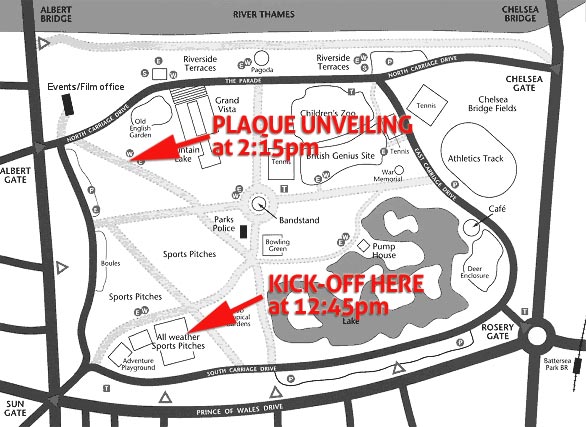 Location of events in Battersea Park
Location of events in Battersea ParkFrom midday, there will be a curtain-raising Year 7 five-a-side football tournament between Eaton House the Manor School, Sussex House School and Battersea Park School on the All Weather Pitches. Small goals will be kindly supplied by Bazooka Goal.
This will be followed at 12:45pm by the match launching The Ball 2014 on its route to the 2014 World Cup in Brazil. There will be introductory speeches, though sadly Richard Tims of Sheffield FC has been taken ill and will not be able to attend. Expect rambling words from the SOF crew instead! The first half of the game will be played under the original association football rules with some players in period dress and the second half under the modern FA rules. Michael Toft Street Soccer will take on 1-v-1 street skills challenges at half time.
At 2:15pm there will be a dedication of an official Green Plaque to mark the 150th anniversary of the first official football match to FA rules. Invited guests include Elected Members of the Council, London FA, Friends of Battersea Park, local historical societies and many others.
Members of the cult band New Model Army including lead singer Justin Sullivan are going to play. NMA has written and recorded the song “Beautiful game” especially to support The Ball’s journey. Pre-order your copy here!
UPDATE this from Battersea Park regarding footwear:
I believe the majority of people have not used our venue before. Please advise them it is not a 3G astroturf, and it would be most helpful, if you could inform everyone of the details below. I am sure you will agree, it would be a shame if someone was prevented from playing, if they did not have the correct, and clean footwear for our surface.
Our pitches have recently been re-surfaced. (At great expense I must add) However all the same rules apply especially with regards footwear etc. NO Football boots of any description. (No Moulded, No Bladed, and No Studs), and of course all footwear must be clean, and not soiled in any way. Please be vigilant on this.
Also for all those who plan to come already changed. Please ask them to make use of the concrete pathways, and not walk or run across any grass areas. This applies to everything warm ups, fitness runs etc.
Could this also be conveyed to all your opponents etc. You know the drill, thank you
Sport Club Corinthians Paulista in Sao Paulo, Brazil have signed a replica of the 2014 ball to support Spirit of Football’s community activities in Brazil in the run up to the epic football pilgrimage that The Ball 2014 will undertake over six months from England to Brazil. Check out the video…
S.C. Corinthians Paulista, named after the skilled amateur Corinthians team from England which toured Brazil in 1910, have put their considerable weight (they are reigning FIFA Club World Champions and Copa Libertadores Champions) behind our project to support the community work that Spirit of Football are undertaking across Brazil. From sourcing The Ball in a unique rehabilitation program in Brazil’s prisons to events in schools and favelas across Brazil you can find out about Spirit of Football’s Brazilian work here.
On January 9th 2014, Spirit of Football CIC will kick-off football’s Olympic Torch (The Ball 2014) on its fourth journey from the home of football in London to the FIFA World Cup in Brazil. Aris F.C. fans plan to take part in the kickoff by bringing the blessings of the Greek Gods from Mount Olympus to London with them – in the form of The “Spirit of Aris” Ball, a replica of The Ball 2014.
Spirit of Football visited Thessaloniki in October 2012 and led an EU workshop at the 3rd Model Experimental Primary School of Evosmos. During this visit, Andrew Aris, a director of Spirit of Football whose family name just happens to be Aris, found out about the spirit of football at Aris F.C. first hand:
“We turned up unannounced at the Aris Sports Cafe and before we knew it, we were being given a tour of the stadium by Communications Manager Nikos Stakias, kicking a ball on the hallowed pitch, and being introduced to officials and fans. It was a fantastic welcome into the Aris F.C. family and very representative of the spirit of football that we felt during our entire stay in Thessaloniki.”
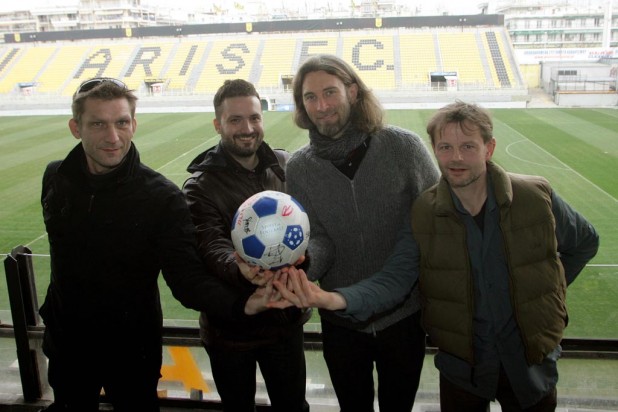 Spirit of Football meet Nikos Stakias of Aris FC
Spirit of Football meet Nikos Stakias of Aris FCThe Spirit of Aris Ball was officially unveiled on Saturday 3 February 2013 with a press conference at Aris F.C. It has already been signed by Aris F.C. first team players, prominent members of Aris F.C. fan groups as well as children from the 3rd Model Experimental Primary School of Evosmos. It is planned that many thousands of Aris F.C. fans all over Greece will have signed the Spirit of Aris Ball by the start of 2014, which is a significant year for both Spirit of Football and Aris F.C. It is not only the 150th anniversary of the first official game of football to F.A. Rules (The Ball 2014 kicks off to Brazil on that very day) but is also the 100th anniversary of the founding of Aris F.C.
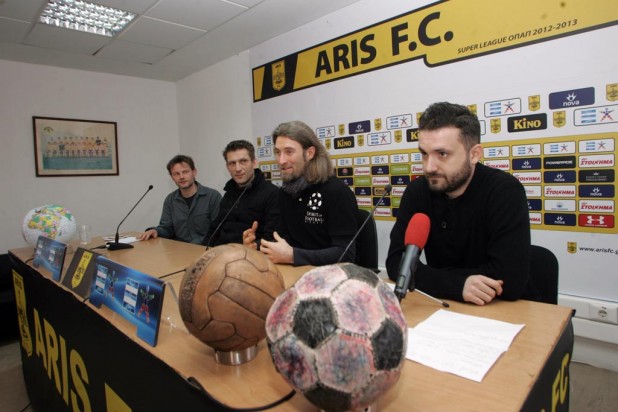 Spirit of Football and Aris FC present the “Spirit of Aris”
Spirit of Football and Aris FC present the “Spirit of Aris”Both organisations love football and agree that it is about more than results, transfers, television, marketing and money – football truly is the world’s game and a way to connect people. Those who love this game share a common spirit that crosses borders and transcends cultures. Accordingly, Spirit of Football would like to invite Aris F.C. fans (and indeed all Greek football fans) to sign The Spirit of Aris Ball and follow The Ball 2014 en route from London to Brazil and to share in the spirit of football.
FC Barcelona and Spirit of Football announced a joint initiative today. To kick it off, all the first-team players signed a ball called “The Barça Spirit Ball” — a replica of The Ball 2014 — which is on its way to Brazil, where the next FIFA World Cup will take place.
This special ball will visit more than 100 schools across Brazil, including schools in a number of favelas. An estimated 50,000 people, mostly children, will encounter it as they participate in workshops run by Spirit of Football.
Read the full FC Barcelona announcement.
The following links will help you find out more about “The Barça Spirit Ball” and Spirit of Football’s activities in Brazil:
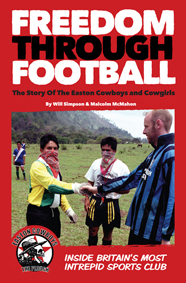 Bristol-based, independent publishers Tangent Books is offering all Spirit of Football followers a 30 per cent discount when you buy the amazing, brand new book, Freedom Through Football: The Story of the Easton Cowboys and Cowgirls. Just click link, add the book to your cart and enter the code sof at the checkout to get the book, delivered free, for just £6.99 instead of the rrp of £9.99.
Bristol-based, independent publishers Tangent Books is offering all Spirit of Football followers a 30 per cent discount when you buy the amazing, brand new book, Freedom Through Football: The Story of the Easton Cowboys and Cowgirls. Just click link, add the book to your cart and enter the code sof at the checkout to get the book, delivered free, for just £6.99 instead of the rrp of £9.99.
Authors Will Simpson and Malcolm McMahon have painstakingly researched the first 20 years of the history of the Easton Cowboys and Cowgirls – an outfit that can without any doubt claim to be ‘Britain’s Most Intrepid Sports Club’. The book has over 200 pages, and two colour sections of photographs of the Cowboys on their tours.
Formed out of a kick-about between a group of punks and kids in Bristol, England, the Cowboys are celebrating their 20th anniversary in 2012. During that time they have played football against the Zapatista Freedom Fighters in Mexico, sent a cricket team to Compton in Los Angeles, organised the Alternative World Cup, played football in Palestine and much more.
A young street artist called Banksy joined the Cowboys on their trip to play against the Zapatistas and the book contains never before published pictures of Banksy at work in Mexico.
What people are saying on Facebook
“Just finished reading the book and want to say a massive well done to Will and Malc… (And yes maybe I did well up slightly at the end) BUY ONE!” – Dom
“I started reading it today and I know it’ll be very good company on the train to and from work this week. In fact I already need a few more copies for friends over here” – Nico
“I finished reading the book last night, it was a cracking read and had some laugh out loud moments. it also made me reminisce of the good times I had with the cowboys in the mid 90s early noughties!!” – Nick G
Review on the Tangent website
“Best ‘sports’ book ever! Don’t be put off by the title, for this book is about much, much more than football (which, incidentally, is now just one of three sports currently played by the various club teams). The Cowfolk, as they are collectively known, are a community-based sports and social club from the heart of inner-city Bristol, who have helped redefine what’s possible when you get a group of amateur sportspeople, professional drunks, activists, misfits and ne’er-do-wells (alongside a few ordinary, decent, everyday folk) together.
The book charts the first 20 years of the club’s history from 1992 to the present day, warts and all. There are tales of dodging army check points in Chiapas during a visit to play teams in the Zapatista communities, taking part in cricket matches in Compton LA against ex-gangsters, heading to the West Bank and literally leaving their mark on the Israeli apartheid wall, and organising Alternative World Cups attended by people from as close as Bedminster to as far away as São Paulo (via Lithuania and the South African township of Diepkloof). There have been a few sad losses during the journey (and quite a few happy additions too), the occasional harsh word, partings of ways, fallouts, fall-ins, love affairs, babies and hangovers. But mostly, it’s about being a part of something that exemplifies everything that is good in human nature.
The book is 229 pages, nicely supplemented with plenty of images (many previously unseen) and extra info, with an additional 32 pages of colour pics (including a couple of that Banksy fellow hanging out with the Cowfolk in Chiapas and doing some rare hand-painted pieces in the villages).”
Don’t miss this chance to immerse yourself in Freedom Through Football at a discount — just use your sof code at the checkout.
Every four years, The Ball leaves for the Opening Ceremony of the Football World Cup from Battersea Park, London because, on the 9th January 1864, the very first official game of FA rules football took place there.
It wasn’t the very first game played by the newly–agreed rules — some of the signatories to the FA’s founding charter couldn’t wait and played a game in Mortlake on the 19th December 1863. Barnes and Richmond played out a 0-0 draw and Richmond, it seems, were so disillusioned with the experience that they eventually signed up to the Rugby code instead.
But we celebrate the match in Battersea Park because it was the first official encounter, not just a practice match by some impatient players eager to get a feel for the game under the new rules. From what we have learnt, the Battersea Park game was the showcase celebration of the new Association Football. The match was played between teams of well–known players selected by the President (Arthur Pember) and the Secretary (Ebenezer Cobb Morley) of the FA.
The game ended 2—0 to the FA President’s XIV, with C. W. Alcock, the Lionel Messi of early football, scoring both goals. And yes, the game was 14–a–side because the number of players was decided by the captains at the start of the game. It wasn’t until considerably later that the rules settled on the present 11–a–side arrangement.
One of our missions for celebrating the 150th anniversary of that match in Battersea Park is to try and locate the closest living relatives of those who played in that historic game. The Association of Football Statisticians has published a list of the players names and we’re beginning the process of tracing their ancestors. If you think you can help, we’d love to hear from you, so please get in touch.

